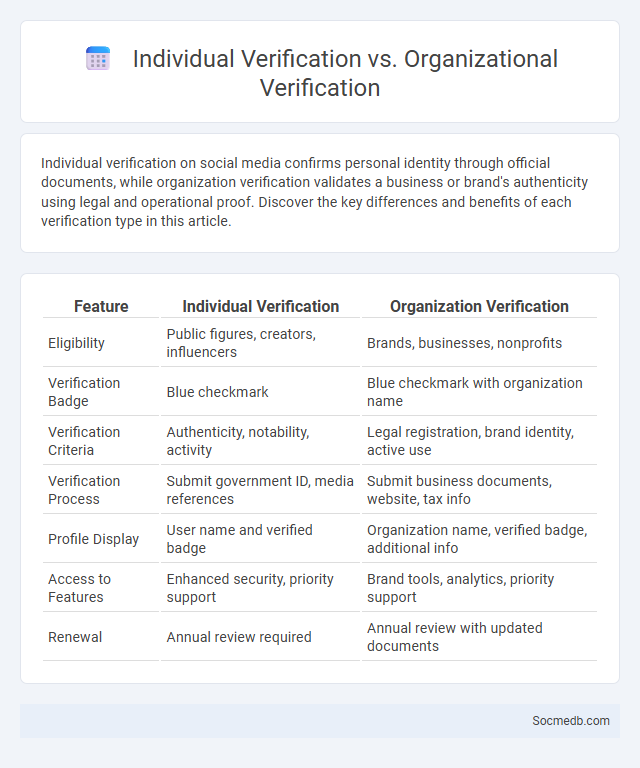
Photo illustration: Individual Verification vs Organization Verification
Individual verification on social media confirms personal identity through official documents, while organization verification validates a business or brand's authenticity using legal and operational proof. Discover the key differences and benefits of each verification type in this article.
Table of Comparison
| Feature | Individual Verification | Organization Verification |
|---|---|---|
| Eligibility | Public figures, creators, influencers | Brands, businesses, nonprofits |
| Verification Badge | Blue checkmark | Blue checkmark with organization name |
| Verification Criteria | Authenticity, notability, activity | Legal registration, brand identity, active use |
| Verification Process | Submit government ID, media references | Submit business documents, website, tax info |
| Profile Display | User name and verified badge | Organization name, verified badge, additional info |
| Access to Features | Enhanced security, priority support | Brand tools, analytics, priority support |
| Renewal | Annual review required | Annual review with updated documents |
Understanding Verification: Individual vs Organization vs Verified Badge
Verification on social media distinguishes individuals, organizations, and the verified badges that authenticate their identities. Individuals often receive verification to confirm their personal identity and credibility, whereas organizations use it to establish brand legitimacy and official representation. Your recognition through a verified badge enhances trustworthiness, making your profile stand out amidst countless accounts.
What Is Individual Verification?
Individual verification on social media is the process where platforms confirm your identity to ensure authenticity, distinguishing real users from bots or fake accounts. This verification often involves submitting government-issued IDs, linking official websites, or verifying phone numbers to secure your profile. Having this verified status boosts your credibility, enhances account security, and increases trust among your followers.
Exploring Organization Verification
Organization verification on social media ensures your brand's authenticity by confirming its official status, which enhances trust and credibility among followers. Platforms like Facebook, Twitter, and LinkedIn offer verification badges that signify verified organizations, helping reduce impersonation risks and improve search rankings. Securing this verification empowers your organization to maintain a trustworthy online presence and increases user engagement.
The Significance of the Verified Badge
The verified badge on social media platforms enhances your credibility by confirming the authenticity of your profile, distinguishing you from impersonators and fake accounts. This symbol significantly boosts trust among followers and increases engagement rates, driving better visibility for your content. Platforms like Twitter, Instagram, and Facebook use this badge to highlight influential or notable figures, helping users quickly identify genuine accounts.
Key Differences Between Individual and Organization Verification
Individual verification on social media typically requires personal identification such as a government-issued ID to confirm the authenticity of a single user. Organization verification involves providing official business documents, tax identification numbers, or proof of affiliation to establish legitimacy. Your choice depends on whether you represent a private individual or a registered entity, each with distinct verification criteria designed to enhance credibility and trust within the platform.
Criteria for Obtaining Individual Verification
Individual verification on social media platforms typically requires users to provide government-issued identification, ensuring authenticity and preventing impersonation. Platforms assess account completeness, including profile photo, bio, and activity history, to confirm genuine engagement and public interest. Verification criteria also consider adherence to platform policies and demonstrated notability in areas like entertainment, business, or public service.
Requirements for Organization Verification
Organization verification on social media requires submitting official documents such as business licenses, tax filings, or certificates of incorporation to prove your organization's authenticity. Platforms often demand a complete and active profile with consistent branding, including logos, contact information, and website links, to verify your identity. Your organization must comply with platform policies and demonstrate public interest or relevance to qualify for verified status.
Benefits of Having a Verified Badge
A verified badge on social media enhances credibility by confirming the authenticity of an account, which builds trust among followers and potential customers. It increases visibility and prioritizes content algorithmically, resulting in higher engagement rates and expanded reach. Brands and influencers with verified badges experience improved protection against impersonation and can access exclusive platform features for growth and promotion.
Challenges and Common Issues in the Verification Process
Social media verification faces challenges such as identity fraud, account impersonation, and inconsistent eligibility criteria across platforms. Users frequently encounter delays and lack of transparency during the verification review, which can hinder Your ability to build trust and credibility. Addressing these common issues requires improved authentication technology and clearer communication from social media companies.
Choosing the Right Verification for Your Needs
Choosing the right social media verification type depends on your platform goals and audience trust requirements. Official blue checkmarks on platforms like Twitter and Instagram enhance credibility, while niche-specific badges, such as gamer or business verifications, target relevant communities. Evaluating factors like account type, content frequency, and intended reach ensures optimal verification benefits and engagement growth.
 socmedb.com
socmedb.com